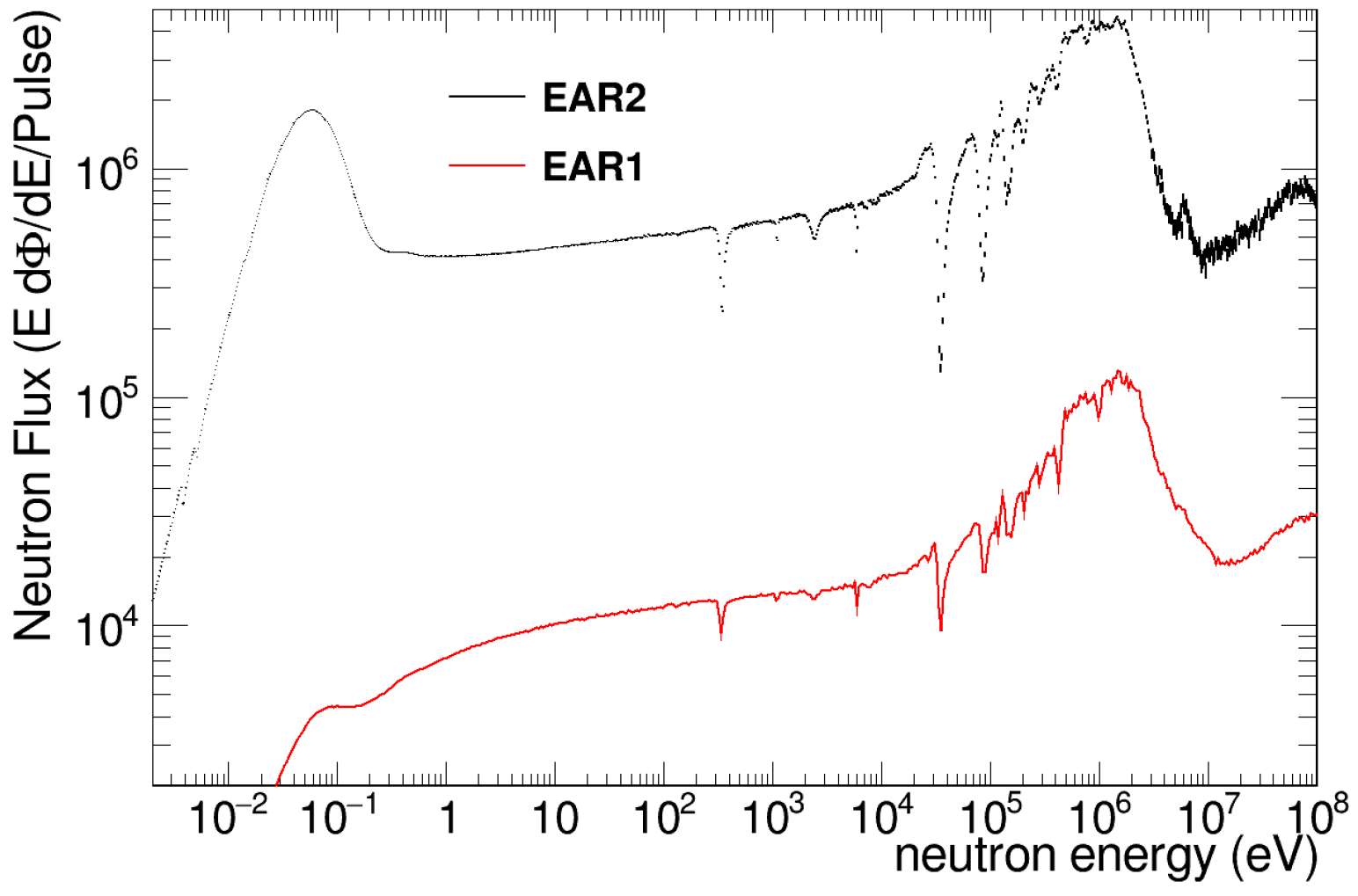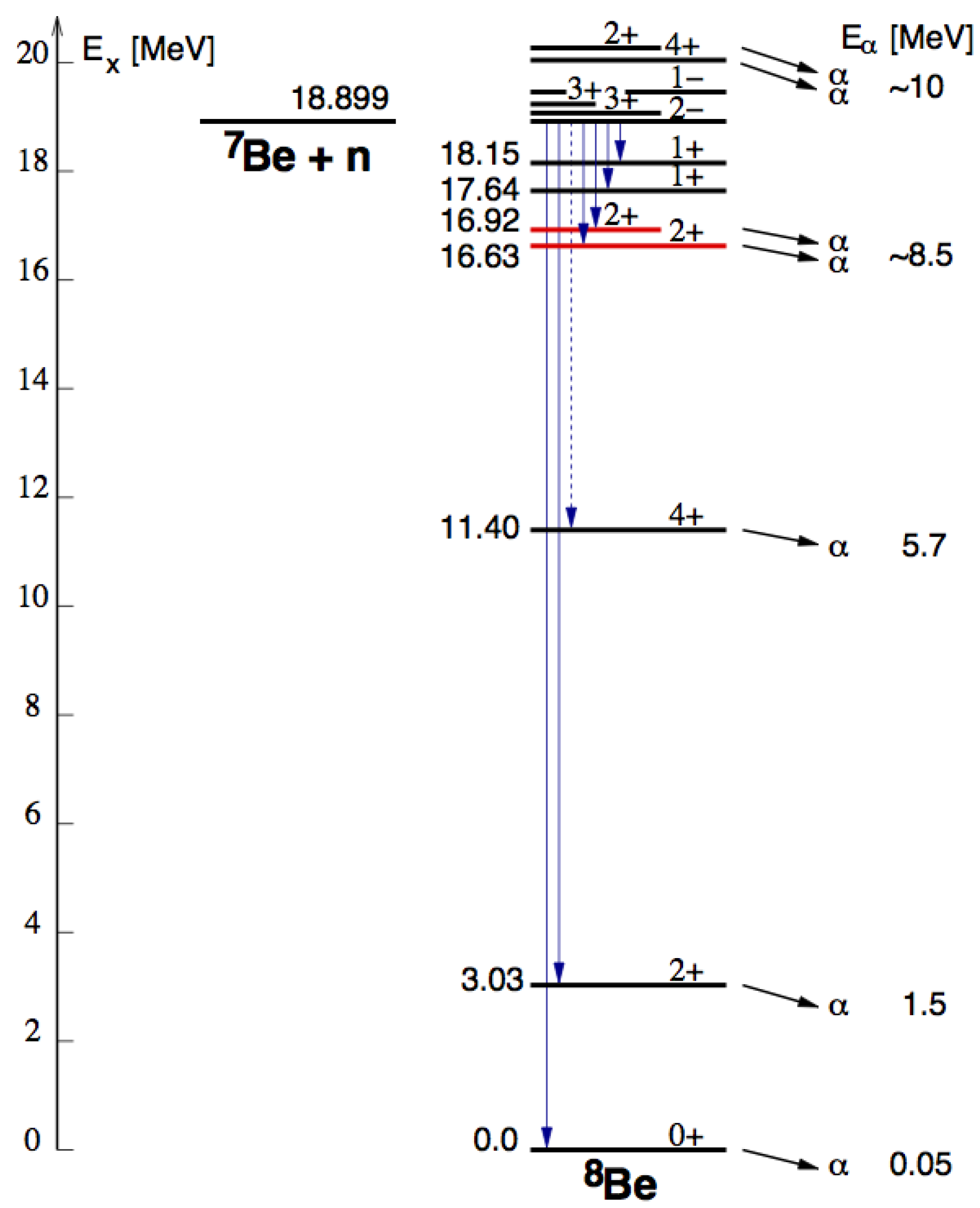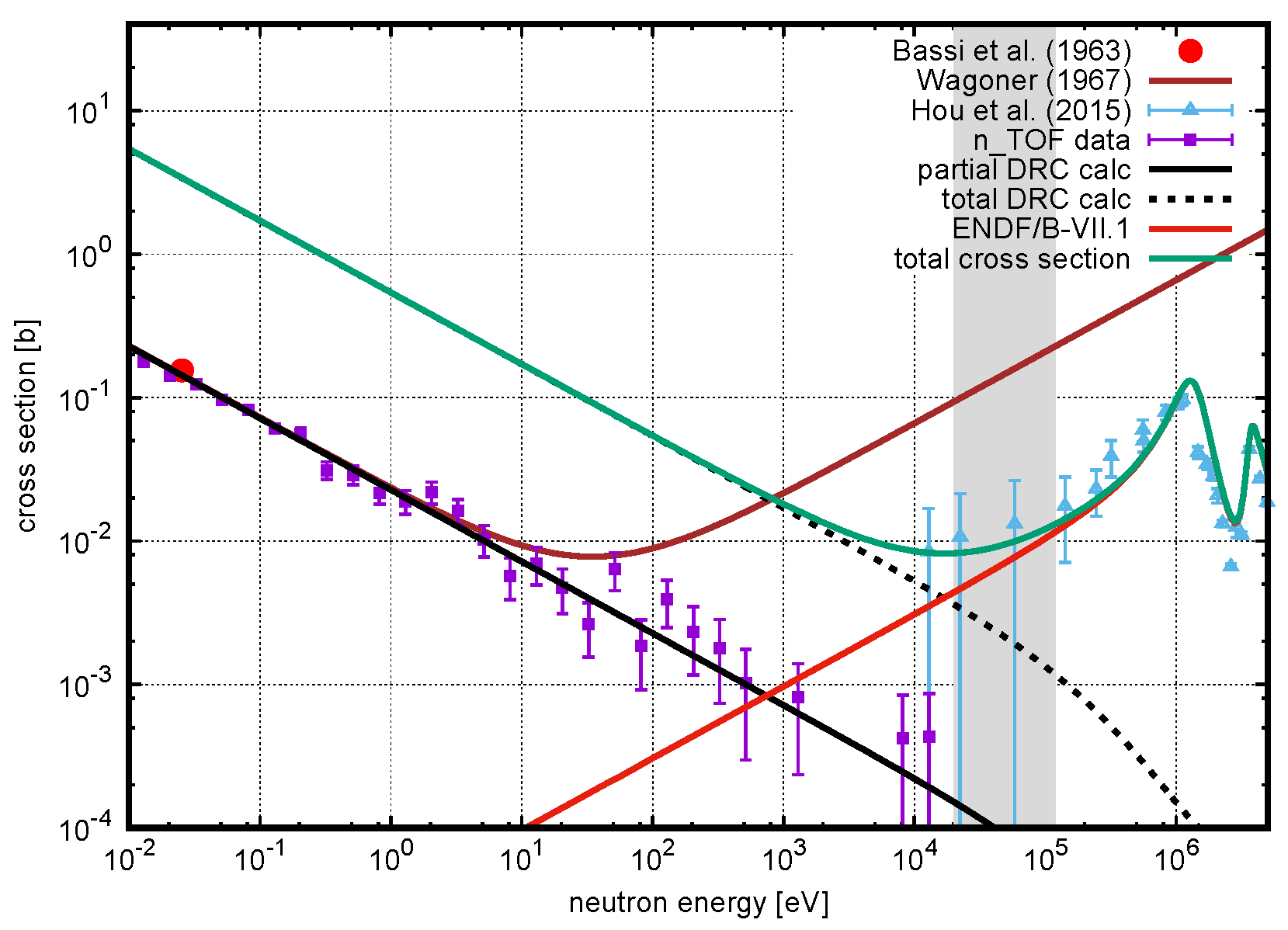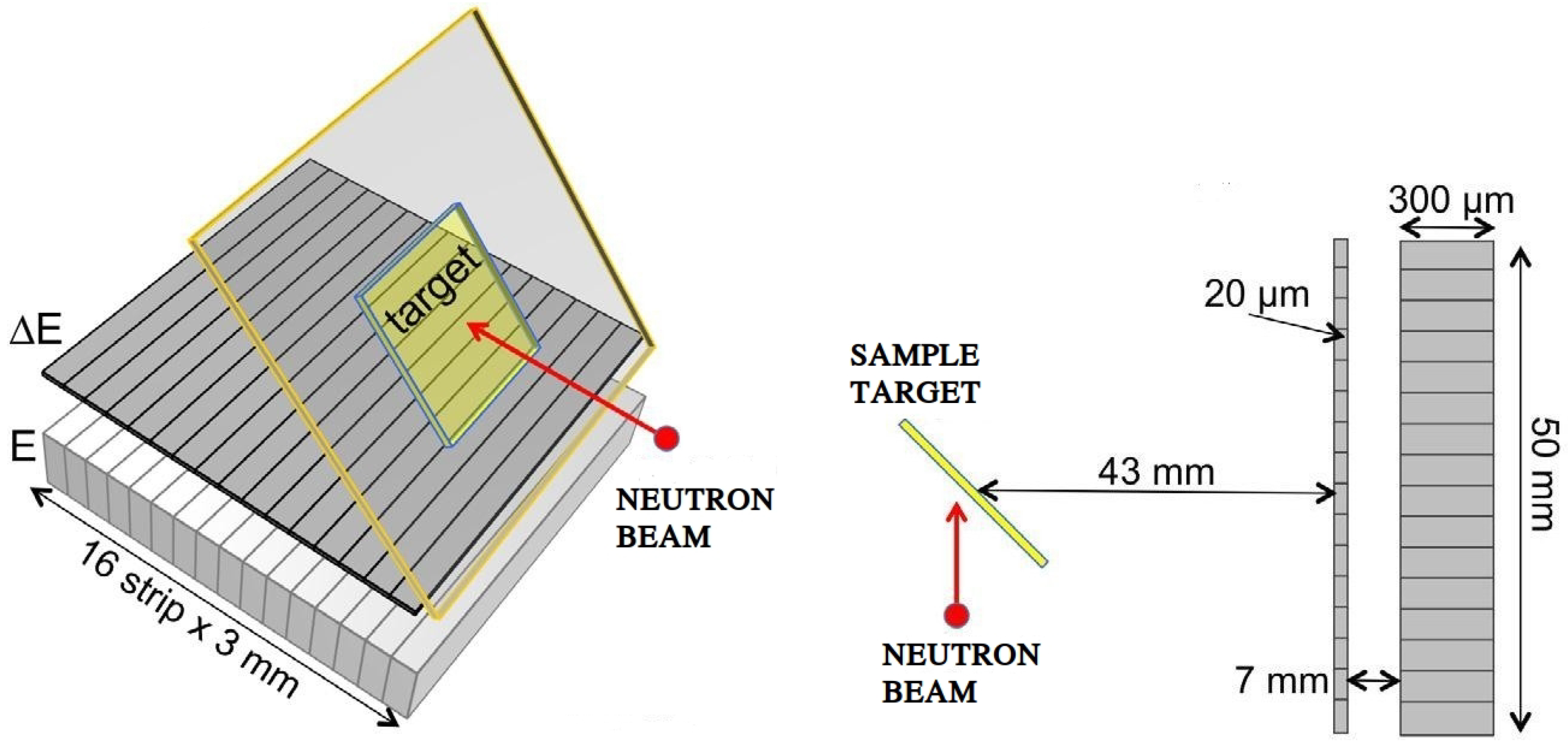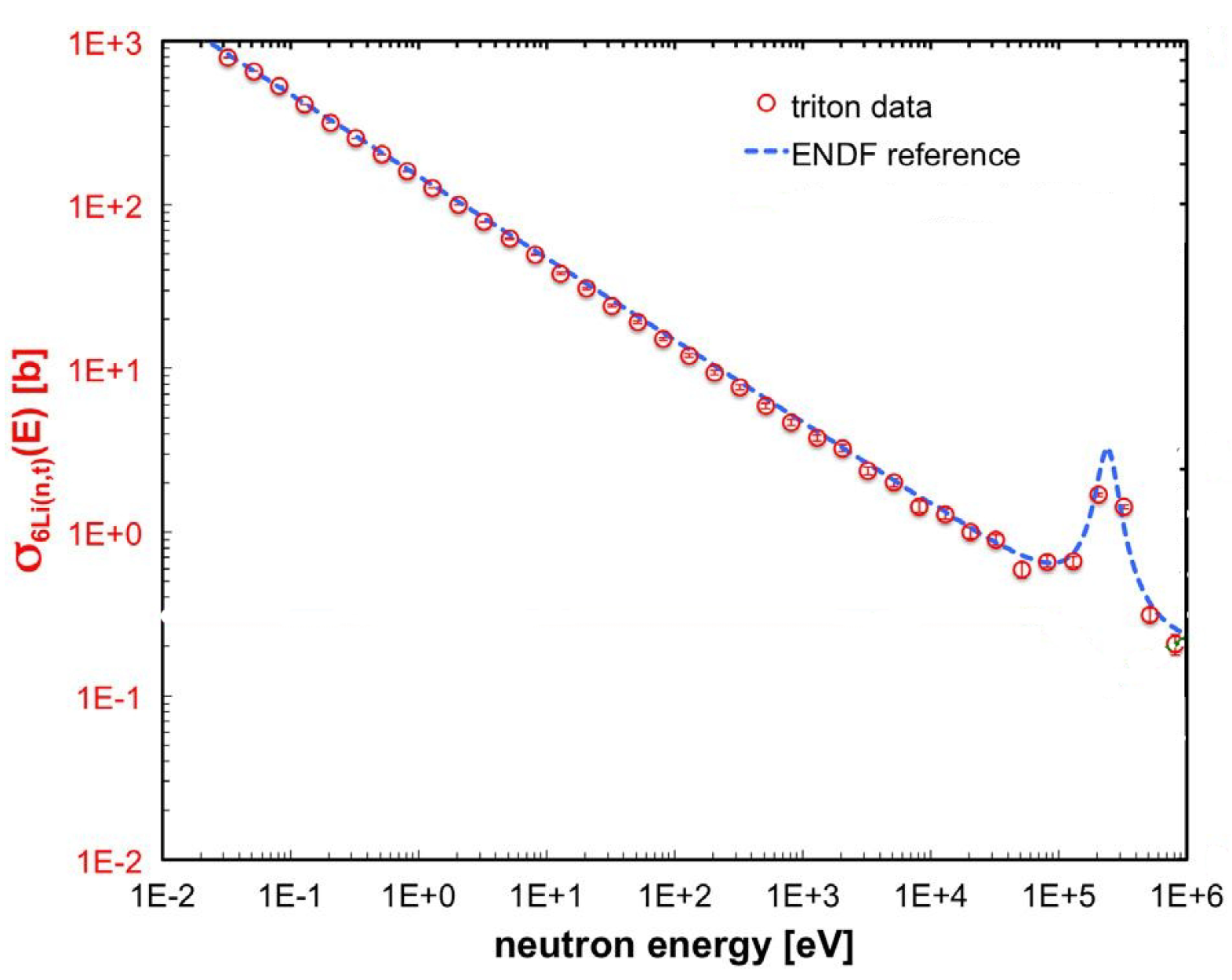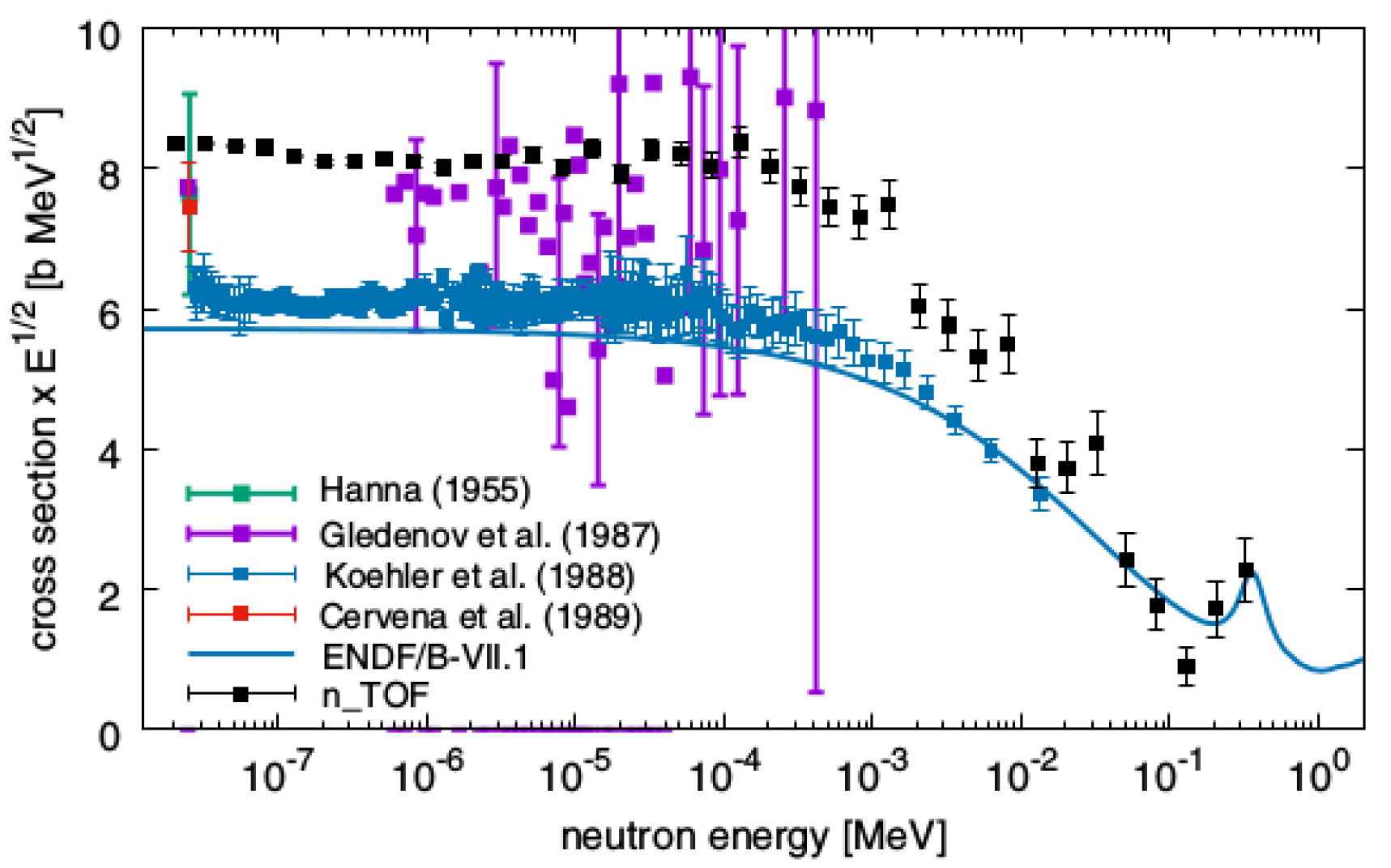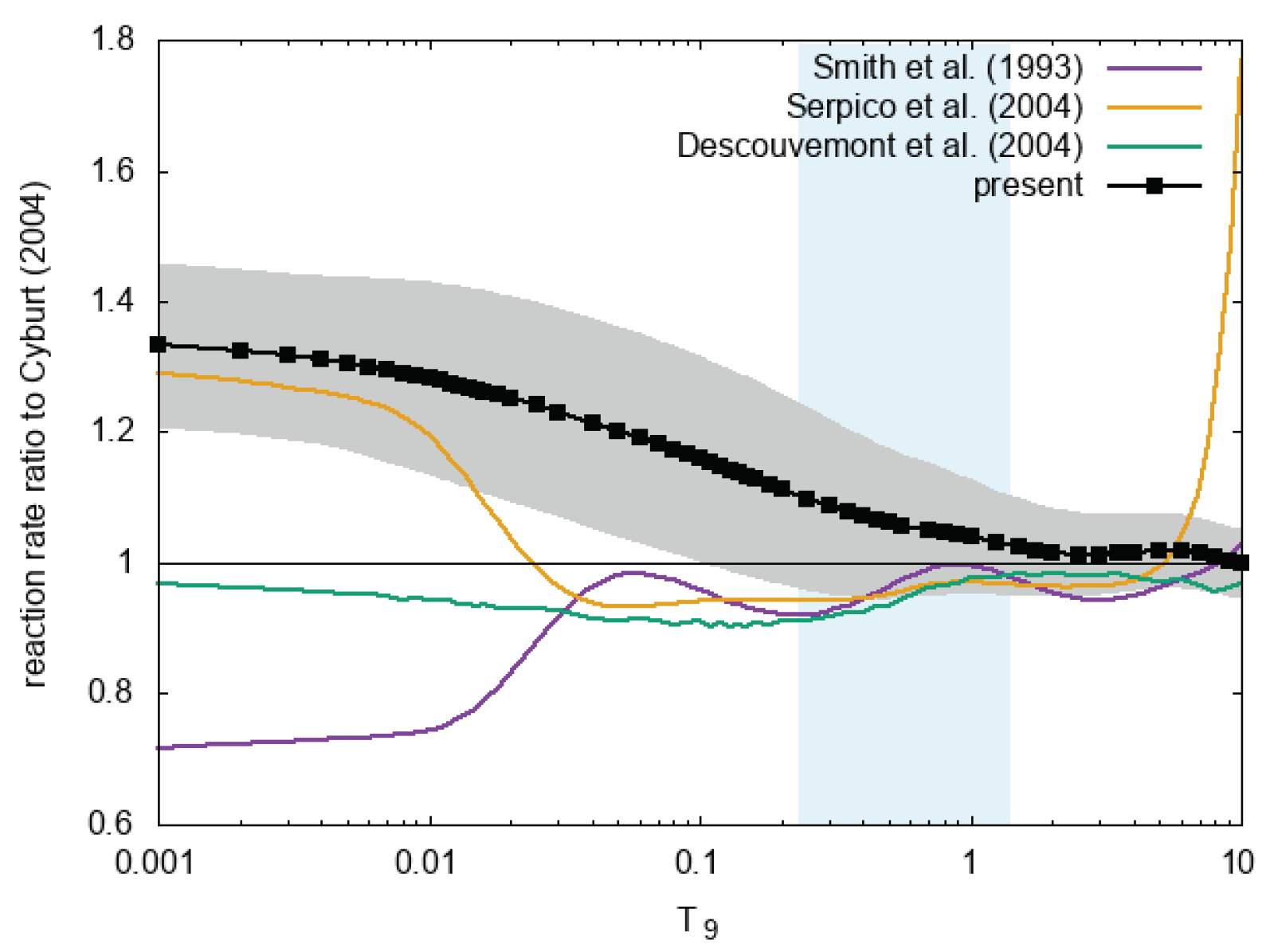1. Introduction
Based on the Standard Model of electroweak and strong interactions, the Big Bang Nucleosynthesis (BBN) theory predicts the production of the lightest nuclides such as D,
He,
He, and
Li in the early Universe. While BBN calculations reproduce remarkably well, the primordial abundances of the lightest elements inferred from observations, a mismatch of a factor of three exists between predictions and the
Li abundance observed in the photospheres of primitive, low-metallicity stars. This discrepancy, known as a Cosmological Lithium Problem (CLIP) [
1], is one of the long-standing unresolved issues in Nuclear Astrophysics and Cosmology.
Several solutions have been proposed for the CLIP, some of which involve new physics beyond the Standard Model. From the point of view of Nuclear Physics, a large experimental effort related to Cosmology has been carried out in the past on a variety of subjects, including antiproton nuclear interaction in the early Universe, extensively studied by the LEAR and ASTROBELIX experiments [
2,
3,
4,
5]. A possible Nuclear Physics solution is related to an incorrect estimation of the destruction rate of
Be. Since 95% of primordial
Li is produced by electron-capture decay of
Be (half-life t
≃ 53 days), a higher rate for neutron or charged particle induced reactions on
Be would lead to a lower
Li abundance.
While charged particle induced reactions on Be have been accurately measured and the corresponding destruction rate calculated, the status of the experimental data on neutron induced reactions, i.e., Be(n, )He and Be(n, p)Li, is quite unsatisfactory. This is mostly due to the very high specific activity of Be (≃ 13 GBq/g), which makes it difficult to procure and handle Be samples of adequate mass and purity.
On the
Be(n,
)
He reaction, although its contribution to the destruction of
Be has always been considered negligible in BBN calculations, no experimental confirmations of this assumption were available up to recently. At thermal neutron energy, only one measurement performed at the ISPRA reactor was reported in literature [
6], which was used by Wagoner et al. [
7] to extrapolate the cross section in the BBN energies range. Other theoretical calculations in the keV energy region differ significantly from each other [
8]. A similar situation was also present for the
Be(n, p)
Li reaction; such a reaction represents 97% of the neutron destruction channel of the
Be isotope and, as a consequence, it plays a key role in the determination of primordial lithium abundance. Despite its importance, the only two data sets covering from thermal to 500 eV [
9] and from thermal to 13 keV ranges [
10] show a systematic difference of up to 30% between each other. Furthermore, the extrapolation to higher energy is inconsistent with the cross section inferred from the time-reversal reaction, the
Li(p, n)
Be [
11].
All these inconsistencies prompted a dedicated experimental program at the n_TOF facility at CERN, taking advantage of the high-luminosity of the neutron beam, spanning from thermal to some GeV [
12], at the recently built second experimental area (EAR2) [
13]. The measurements, performed with two different silicon detector systems, provided for the first time reliable nuclear data on the n+
Be reactions in a wide neutron energy range, allowing to clarify the role of these processes in the context of the Cosmological Lithium Problem.
2. The n_TOF Facility at CERN
At the n_TOF facility, neutrons are produced by spallation process on a lead target using 20 GeV/c protons/bunch with 7 ns RMS pulse width from the Proton Synchrotron (PS). Emitted neutrons, about 300 per incident proton, are subsequently collimated and guided through two beam lines at the two different experimental areas, EAR1 and EAR2, located at 180 m and 20 m from the spallation target, respectively. A layer of water (borated or demineralized) surrounding the spallation target moderates the initially fast neutron spectrum, providing a white neutron energy distribution spanning from a few meV up to the GeV region. The PS repetition rate below 0.8 Hz avoids the overlap of consecutive neutron bunches.
Both
Be(n,
)
He and
Be(n, p)
Li reaction cross-sections have been measured in the second experimental area, n_TOF-EAR2, characterized by an extremely high instantaneous neutron flux of 10
neutrons/pulse, 40 times higher than the one in EAR1 (see
Figure 1). These characteristics make EAR2 ideal for measurements on isotopes available in very small amounts and with short half-lives, as is indeed the case of
Be. More details on the EAR2 neutron beam can be found in Refs. [
12,
13].
3. The Be(n, )He Reaction
3.1. The Experimental Setup
The samples for the
Be(n,
)
He measurement were prepared at the Paul Scherrer Institute (PSI), Villigen, Switzerland. Thanks to the high selectivity of the experimental setup to the two alpha particles emitted in the reaction, only a chemically pure sample material was required. Two samples of 3 cm in diameter were prepared with ≃18 GBq of activity each; one was electro-deposited on a 5
m thick Al foil and the other one was droplet deposited on a 0.6
m thick low-density polyethylene foil. A more detailed description of the samples preparation is reported in Ref. [
14].
The detection system consisted of two Si-
Be-Si sandwiches placed directly in the neutron beam. The Si detectors were 3 × 3 cm
in area and 140
m in thickness. The stack of detectors was placed in a 1 cm thick Pb shielded chamber for radio-protection purposes and the whole assembly was mounted in the vertical neutron beam of EAR2. Such a system allowed to detect in coincidence (within a 100 ns time window) the alpha particles emitted in the reaction, providing a peculiar signature of the occurrence of the
Be(n,
)
He reaction while rejecting all background components (see
Section 3.2). Several performance tests and data quality checks have been performed prior to the measurement in order to verify its feasibility, the radiation resistance and background rejection capability of the detection system. The tests indicated an upper limit of 10 keV the neutron energy that could be reached in the measurement, due to the recovery time of the Si detectors after a “
-flash” [
13,
15], the large flux of gamma-rays and relativistic charged-particles coming from the n_TOF target.
3.2. Data Analysis
The reaction proceeds through various energy levels of
Be populated by gamma-ray transitions as shown in
Figure 2. Taking into account that alpha particles in their ground state are bosons, for the total angular momentum and parity conservation rules allow only 0
, 2
, 4
... states to decay.
Channels involving the ground state and the first exited level result in the emission of low-energy alpha particles (≲1.5 MeV each), which could not be detected in the enormous 478 keV Be gamma-rays background. Moreover, the level 4 at 11.40 MeV can be populated only by second order magnetic transitions (M2) that are strongly suppressed. Therefore, only the partial cross sections involving the highest allowed excited levels (2) between 16.6 and 18.1 MeV, which lead to the emission of two alpha particles with energy ≳8.5 MeV each, are accessible experimentally.
The background component related to the gamma-rays from the Be decay corresponds to signals of a few tens of keV, although the large pile-up due to the very high activity could mimic a high-energy deposition event. A similar argument applies to the pileup of protons from the competing Be(n, p)Li reaction, characterized by a very large cross section at thermal neutron energy (≃39 kb). These background components were significantly reduced by applying a 2 MeV threshold on the signal amplitude.
The random coincidences produced by residual pileup events were estimated by analysing coincidence events of uncorrelated Si detectors (i.e., belonging to different arrays). Within statistical uncertainties, the count rates of both Si-Be-Si arrays are constant in time, and on average two orders of magnitude higher than random coincidences during the whole measurement campaign.
3.3. Results
Figure 3 shows the measured partial cross section from 10 meV to 10 keV, obtained as a weighted average by uncertainties of the results from both arrays; data are affected by an overall systematic uncertainty lower than 10%, mainly due to the uncertainty of the sample mass and to the position of the neutron beam (see Refs. [
15,
16]. The result of this measurement at thermal energy was found to be consistent with the only previous existing measurement reported by Bassi et al.
Theoretical calculations [
17] were performed in order to estimate the branching ratios between different transitions, necessary to determine the total cross section from the partial one measured at n_TOF. Since the n_TOF data extend only up to approximately 20 keV, in order to determine the total cross section in the whole region of interest for BBN calculations, the n_TOF data were combined with data from the indirect measurements of the
He(
, n)
Be and
He(
, p)
Li reactions [
8], together with the evaluated cross section of ENDF/B-VII.1 [
18] based on an R-matrix analysis of indirect reactions. The resulting cross section, from thermal neutron energy to a few MeV, is shown in
Figure 3 (green curve). In general, the new cross section shows a trend incompatible with Wagoner’s compilations used up to now for BBN calculations. In particular, the total cross section is more than a factor of ten higher at thermal neutron energy, but lower, by a similar factor, at high energy. The lower cross section in the energy range of relevance for BBN translates into a factor ≃10 lower estimated rate for this reaction. As a consequence, these results indicate that the
Be(n,
)
He reaction cannot play any role in the Cosmological Lithium Problem, which in fact worsens by a few percent [
16].
4. The Be(n, p)Li Reaction
4.1. The Experimental Setup
The measurement of the
Be(n, p)
Li reaction required a completely different sample and detection concept. As for the (n,
) reaction, the sample material was produced at PSI (Villigen, Switzerland) by radiochemial separation of 200 GBq
Be from from the cooling water of the Spallation Induced Neutron Source (SINQ) facility. After chemical purification, the material, in the form of nitrate solution, was inserted in the ion source of the ISOLDE facility at CERN, where an isotopically separated
Be beam was produced and implanted on a 18
m aluminum backing. A sample of ≃1.1 GBq total activity corresponding to ≃80 ng in mass, with a purity of about 99% and 1% of
Li contamination, was produced and immediatelly afterwards inserted in the EAR2 neutron beam line at n_TOF (see Ref. [
14] for more details). The
Li(n, t)
He standard cross section [
18] was used as a reference from thermal to 1 MeV neutron energy. To this purpose, a sample of 1.1 mg of LiF was prepared at INFN Laboratori Nazionali del Sud, Catania, Italy. To match the envisaged size of the
Be sample, the lithium foil was masked with an aluminum opening window of 1.5 × 1.5 cm
and used in the same experimental conditions of beryllium, as shown on the left side of
Figure 4. Apart from being used as reference for the cross section measurement, the
Li(n, t)
He reaction was used for calibrating the detectors, thanks to the known triton energy.
A position-sensitive telescope, made of two silicon strip detectors, of 20
m and 300
m thickness for
E and E detection has been used (see right side of
Figure 4); both silicon detectors had 5 × 5 cm
active area and 16 strips. In order to minimize the energy straggling of emitted protons, the sample was tilted relative to the neutron beam direction by 45
(see right side of
Figure 4). The whole setup was operated in a vacuum chamber, placed in the vertical beam line. Before the measurement, tests were performed to study the detector response and the expected background.
4.2. Data Analysis
In order to identify protons emitted in the reaction, a coincidence between the strip in the E detector and the corresponding strips in the E detector was required. The width of the time coincidence window was chosen to be 100 ns. To extract the cross section, the geometrical efficiency of the telescope and the beam-sample convolution function needed to be determined. The detection efficiency of the setup was simulated by means of the Monte Carlo code GEANT4, in which a detailed software replica of the setup was implemented, including the samples and sample backing. The simulations were performed for different neutron beam energies, assuming a Gaussian shape reproducing the experimentally determined neutron beam profile. For both the cross section and angular distribution of emitted products, the GEANT4 High Precision model was adopted in the simulations, which uses the cross section and angular distribution of emitted products from evaluated data libraries. In the case of the tritons from the Li(n, t)He reaction, the emission is isotropic up to a few keV, but becomes forward peaked at higher energies, leading to a drop in the detection efficiency. For the protons emitted in the Be(n, p)Li reaction, evaluations assume isotropic emission at all neutron energis, resulting in a constant efficiency. Finally, simulations were also employed to calculate the beam-sample convolution factor, the sample dimension being smaller than the neutron beam profile, and in the case of the Be deposit, highly inhomogeneous.
The
Be(n, p)
Li cross section was extracted relative to that of the
Li(n, p) reaction, from the ratio of the number of normalized counts and taking into account the ratios of the efficiencies and beam-sample convolution factors. A check of the analysis procedure was performed by extracting from the n_TOF data the
Li(n, t)
He cross section. The very good agreement (better than 5%) found between data and the evaluations (see
Figure 5) in the whole energy range validates the method used in the analysis and provides some indication on the related uncertainty.
One of the main background sources affecting the measurement is related to the
N(n, p) reactions in the sample backing. In order to estimate this, a sample made of the aluminum backing has been used. This background was identified, subtracted, and its contribution was found to be important only for neutron energies above ≃330 keV, a value representing the upper limit of the n_TOF data. Other sources of systematics come from the detector efficiency that reaches almost 10% at 50 keV and 8% due to the inhomogeneity of the
Be sample deposit. More details can be found in Ref. [
14,
20].
4.3. Results
The
Be(n, p)
Li cross section determined at n_TOF is shown in
Figure 6, compared with previous measurements and with the ENDF/B-VII.1 evaluated data. Present data are approximately 40% higher than those of Koehler [
10] and ENDF evaluations, but at thermal energy they are consistent with the results of Refs. [
9,
21,
22].
In order to extend the
Be(n, p)
Li reaction cross section at BBN energies, data from Sekharan et al. [
11] from 35 keV to 2 MeV on the time-reversal
Li(p,n)
Be reaction have been used. The n_TOF data, combined with the cross section extracted from the inverse reaction, have been fitted in Single Level Breit–Wigner approximation (SLBW) by means of an R-matrix code, in order to obtain a smooth cross section all the way from thermal neutron energy to a few MeV, covering in particular the energy region of interest for BBN calculations. Such cross section has then been convoluted with the Maxwellian neutron energy distribution corresponding to various stellar temperatures, and the resulting Maxwellian averaged cross section (MACS) has been used to calculate the astrophysical reaction rate, as a function of the temperature in units of T
(i.e., 10
K), in the range from 10
to 10. In
Figure 7, a comparison of the reaction rates of the present work with some of the previously adopted rates is shown. In all cases, the ratio of the calculated rate to a reference one reported by Cyburt et al. in Ref. [
1] is plotted in the figure. The gray band corresponds to the experimental uncertainty of the reaction rate that was estimated to be around 10%. The vertical band represents the region of interest for BBN.
Although the measured rate is significantly higher than previous evaluations in a wide range up to T≃ 1, it leads to at most a 12% decrease in the lithium abundance compared to previous calculations.
5. Conclusions
The Nuclear Physics solution for the CLIP sought in the Be(n, )He and Be(n, p)Li reactions has been investigated by measuring the two reactions in a wide energy range at the high-luminosity second experimental area (EAR2) of the n_TOF facility at CERN. The Be(n, )He results indicated that the corresponding reaction rate used in BBN calculation has been so far overestimated. On the contrary, the results on the Be(n, p)Li reaction lead to a new estimate of the Be destruction rate 10% higher than currently believed, and thus in a corresponding decrease of the predicted lithium abundance. Both results therefore finally and unambigously demonstrate that the n+Be reactions cannot solve the Cosmological Lithium Problem, ruling out one of the last possible Nuclear Physics solutions of this long-standing issue, while leaving open all other possible scenarios.
